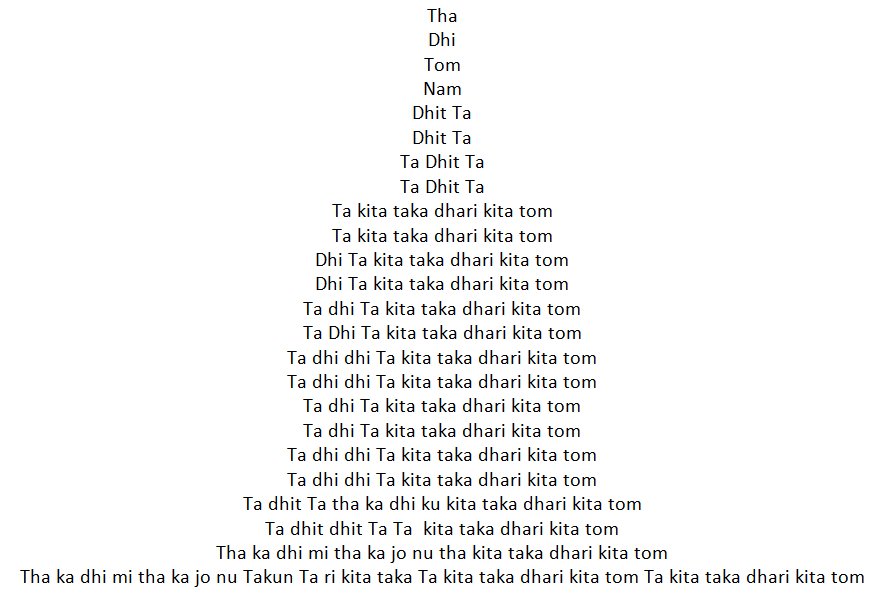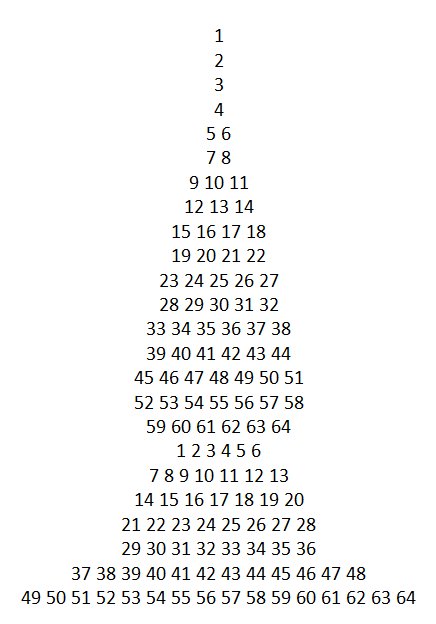
|
 |

|
 |
The Anjali Yathi - M Subhashini Vijay Santhanam e-mail: s_subashini@hotmail.com November 11, 2020 Arrangement of rhythmic percussive syllables to match a pattern that pictorially represents a shape or object is called a Yathi. This Yathi is a common phrase set up or pattern that is typically used at the very end of several time cycles of creative rhythmic meandering to make a pretty flourish that elegantly leads to the beginning of the new rhythm cycle or Samam. Typically, the pattern of the flourish or teermanam repeats thrice. There are typically 6 accepted Yathi in practice. Dancers as well as percussionists use these throughout their works. 1. For instance, when a korvai ends in ta dhingi na Tom, ta dhingi na Tom, ta dhingi na Tom it is an even length ending called SAMA YATHI. 2. When it has an inverted triangle pattern, it looks like the end of a cow's tail tapering from big to small.
Thadhingi na Tom
This is called GOPUCHA YATHI.Dhigi na Tom Gi na tom Dhi tom Tom 3. When the delta is open and goes from a narrow mouth to wide, it is called a SROTHVAHA YATHI and it is said to represent the triangular estuary formed by the river opening into the sea. Jham
Thajham Thathajham Ta ki ta jham Thadhingi na Tom 4. When two triangles come together in the form where the big tapers to small and again from small to big, it looks like the musical instrument called Damaru. It was played by Lord Shiva himself. This is called the DAMARUKA YATHI. Thadhit ta kitathaka Dharikita tom
Dhit ta kitathakadharikita tom Ta kitathakadharikita tom Kitathakadharikita tom Dharikita tom Kitathakadharikita tom ta kitathaka Dharikita tom Dhit ta kitathakadharikita tom Thadhit Ta kitathakadharikita tom 5. When the two triangles are growing towards the center, it looks like the musical percussion instrument mridangam and hence it is called the MRIDANGA YATHI. Thaki ta
Thakadhimi Thakathaki ta Thakadhi mi ta ki ta Thakadhi mi thakathaki ta Thakadhi mi ta ki ta Thakathaki ta Thakadhi mi Thaki ta 6. The sixth and last pattern is the one with no rules and no pattern. It is called a VISHAMA YATHI or without any pattern. The purpose of this paper is to propose a new pattern called the ANJALI YATHI. Inspired by the numerous emoticons that convey so much meaning over social media using simple stick diagrams, the scope of using patterns of rhythm to communicate an underlying emotion is pretty thrilling. Going by our pattern formation above, the Anjali mudra is the kapota namaste Samyuta hasta used by pressing the tips of the fingers of both cupped hands with the wrists touching and thumbs touching with some space in the center. It is easily achieved in yathi format using the Mridanga Yathi along with a Strotvaha Yathi on the bottom to denote the hands below the wrists. Tha
Thaki ta Thakadhimi Thakathaki ta Thakadhi mi ta ki ta Thakadhi mi thakathaki ta Thakadhi mi ta ki ta Thakathaki ta Thakadhi mi Thaki ta Tha Jham Thajham Thathajham Ta ki ta jham Thadhingi na Tom While it is completely possible to argue that the hands need to be flatter and the pattern does not exactly match the hands held in Anjali mudra, the variations could be debated and then we could come up with an accepted practice. This idea occurred as an attempt to try to make a fitting final jathi to a poly rhythmic composition. After exhausting the symmetry, the only path left was to completely surrender. So the pattern of bringing the hands together in all humility and reverence for a final surrender or Charanagati was the idea. Here is the Anjali Yathi in 4 Avarthana cycle, adi talam. You can watch and hear it in the video:   I am incredibly grateful to mridangist Guru Bharadwaj for his support as a sounding board for the idea.  M Subhashini Vijay Santhanam is the artistic director of From Within Nucleus Dance Company based in Seattle (USA), Bangalore, Hyderabad and Chennai (India). Post your comments Please provide your name and email id when you use the Anonymous / blog profile to post a comment. All appropriate comments posted with name & email id in the blog will also be featured in the site. |